.
Art of Asia
India: Birthplace of Buddhism
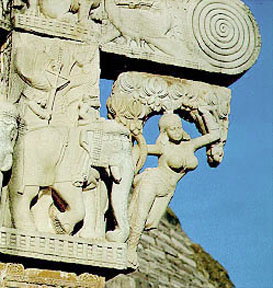
Detail of Yakshi at Great Stupa, Sanchi |
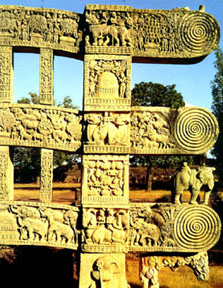
East Gate of the Stupa, Sanchi |
It would be difficult to approach Indian art without considering its
religious traditions. Early on, images of nature gods pervaded India's
sculpture and architectural reliefs. This tradition continued long after
Buddhism became a major religion. Guatama Siddhartha was born a prince
in India around 563 BCE. Having renounced his royal status (at around
the age of 29), he wandered into the wilderness to seek enlightenment
(nirvana). Having achieved this, he began his life as a teacher and
spread his wisdom to a group of devotees, who would spread his knowledge
- creating the foundation for Buddhism. By around the third century
BCE, Buddhist imagery and architecture began to appear, as in the elaborately
sculptured gates that surround the Great Stupa in Sanchi.
The Yakshi above is a female fertility spirit, a leftover symbol from
an ancient religion which venerated nature gods. Though Buddhism is
often seen as a religion of renunciation, it actually embraces sensuality
in order to transcend it. The voluptuous body of the yakshi suggests
her powers of fertility. She wraps herself around the branches, causing
it to flower. |
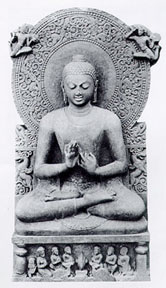
Seated Buddha, 5th c. CE |
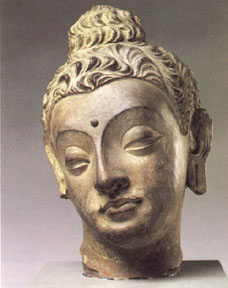
Head of Buddha, Gandhara style, 5th c. CE |
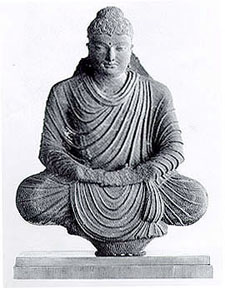
Gandhara Buddha on Lotus
|
The very earliest Buddhist images did not even depict the Buddha, instead
symbolizing him with his empty throne or the Bodhi tree under which
he is known to have attained enlightenment. Several centuries after
his death, we begin to see images of the Buddha seated on his throne
or on a lotus flower (symbol of enlightenment).
This tilted head of Buddha would have once sat on his full body, similar
to the one at right (they are from the same region, now part of Pakistan).
This area had extensive contacts with the Roman empire at this time,
which influenced the western-style of hair, linear carving of features
and graceful swirls of Greco-Roman draperies.
By the end of the 7th century, Buddhism had spread its influence to
China, Japan, and Southeast Asia. It was, however, supplanted in India
by a revival of Hinduism, which now remains the dominant religion. |
The Rise of Hinduism
in India
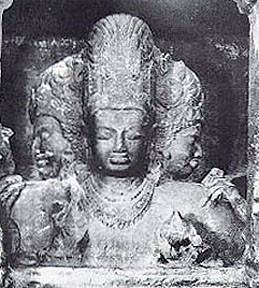
Brahma, Shiva, and Vishnu |
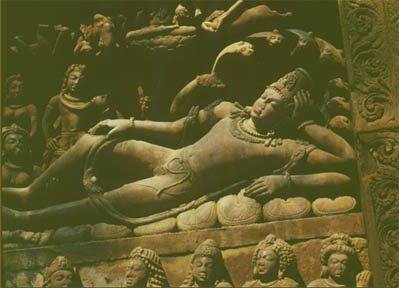
Sleeping Vishnu, Gupta Temple, Deogarh - 5th C. AD |
Hinduism is populated by a pantheon of distinct deities... too many
for me to mention in this brief introduction. The three major Hindu
deities include Brahma (Creator), Shiva (Destroyer), and Vishnu (Preserver),
which constitutes the Great Trinity. The Vishnu at right dreams the
world while he sleeps. He is usually thought of as benevolent and mild,
granting salvation to his followers for their devotion. |
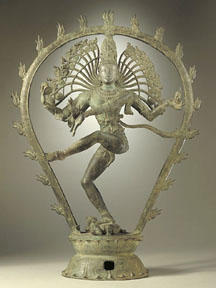
Shiva, Lord of the Dance |
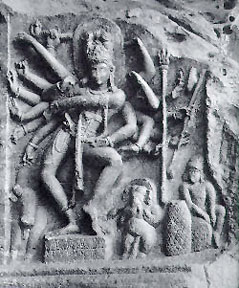
Shiva, Kailesh Temple, Ellora |
| Shiva (or Siva) is often presented in his form as the cosmic dancer.Ê
He is believed to be the source of all movement within the cosmos, and
so his dancing is what makes the world go round.Ê The dance is said to
be performed in a sacred place called 'Chidabaram', the center of the
universe, which is in reality within the human heart. The many hands form
gestures called "mudras", each intending to represent a different
aspect of the god. |
Hindu Temples of Angkor
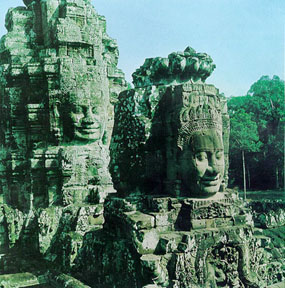
Angkor Thom, Cambodia |

Angkor Wat, Cambodia |
Some of the most interesting archeological sites are the many temples
and palaces built in Angkor, India. Created by Khmer kings, the imagery
tends to combine both Buddhist and Hindu traditions. The gateways to
the ancient temple city of Angkor Thom were protected by immense towers
carved with giant faces of Boddhisattvas surveying the four directions.
The Temple of Angkor Wat was dedicated to the Hindu god Vishnu during
the middle of the 12th Century. The temple took over 30 years to construct,
and it enshrines some of the world's most beautiful examples of Khmer,
Buddhist and Hindu Art. Covering an area exceeding 80 acres, the ancient
complex consists of five towers - representing the five peaks of Mount
Meru, the Home of the Gods, and the center of the Hindu Universe. The
site was left by the Khmer people in the 15th century, and was not rediscovered
until 1861, when the French hacked it out of the jungle that crept up
around it. |
| The temple's richly decorated reliefs and sculptures are in ruins due
to the humid climate, the algae and fungi covering its surface, the roots
of trees that have grown up around it, the acidic content of bat droppings
, insects infesting the crevices, and water erosion. In addition, since
its discovery, vandals have become a huge problem. Eager to sell sculptures
to collectors, they have even cut reliefs out of the rock. Cambodia has
long been in a war zone, so there is also much damage from bullet and
mortar wounds at the site. |
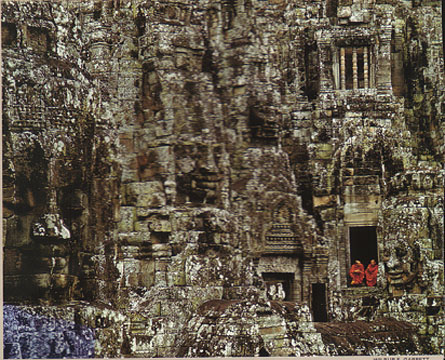
Monks Amid the Angkor Ruins
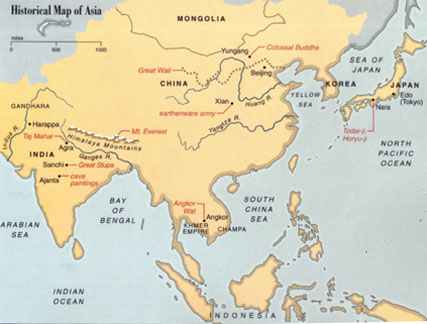
China:
The Great Dynasties
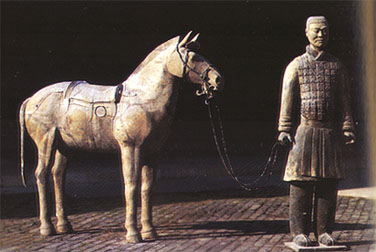
Xian Soldier and His Horse, earthenware |
|
In 1974, well-diggers accidentally uncovered part of the tomb complex
of the first emperor of China, Shi Huang Di. Buried since 210 BCE, the
life-size soldiers guarded the tomb in military formation, accompanied
by horses and attendants... totalling over 7000 figures! The scale of
such a project is an amazing feat in itself, but one's appreciation
increases when we discover that each sculpture is an individual persona.
None are replicated, and the degree of naturalism in each suggests that
the emperor had a large group of very accomplished sculptors. More recently,
further archeological digs in this region have unearthed a similar array
of scribes (clerks), suggesting that the entire court may have gone
into the tomb. |
The Spread of Buddhist Imagery
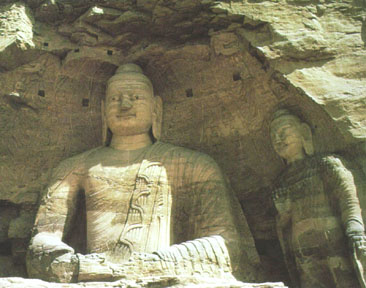
Colossal Buddha, Shanxi (45 feet tall), 5th century |
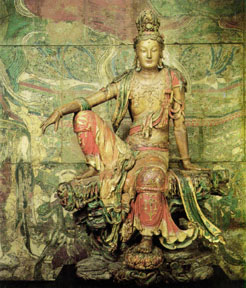
Guanyin, Song Dynasty, 1100 |
| Buddhism was introduced to China from India in the first century CE.
The Colossal Buddha at the entrance to Yungang cave is an early example
of the Buddhist influence in China. The figure appears archaic (old style), given a very simple form, geometric folds of drapery, and
smooth planes to his serene expression. The Guanyin, by contrast, sits
in a very active pose. It is asymmetrical in balance, with a lively
swirl of drapery animating its princely pose. The Guanyin is a favorite
subject, a beloved and powerful Boddhisattva that combines feminine and
masculine characteristics (both graceful and robust). |
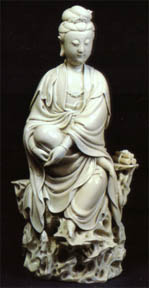
Guanyin the Merciful, 1700 |
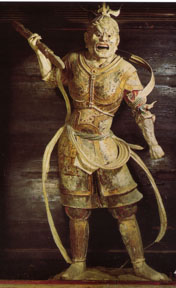
Shukongojin, Nara, Japan 8th c. |
| To clarify masculine and feminine characteristics in Asian sculpture,
I will contrast a porcelain Guanyin figurine from the Quing Dynasty (China's
last dynasty before becoming a republic) with that of a larger wood sculpture
created in Japan. The Shukongojin is a guardian figure for a Buddhist
temple. Known as the "thunderbolt-bearer", he is meant to ward
off demons and evildoers. His animated pose and ferocious expression carries
an aggressive masculinity. In contrast, the porcelain is a feminine version
of a Bodhissattva, expressing containment, modesty, and delicacy. |
Chinese Traditional Painting
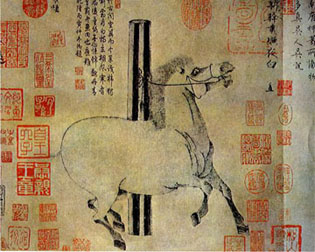
Han Gan, White Night Horse, T'ang Dynasty, 780 |
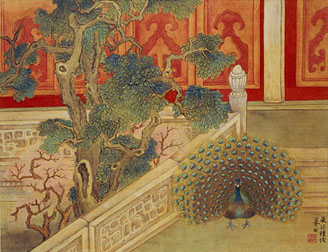
Lu Hu, from Album of Miscellaneous Subjects 1891 |
| The origins of traditional Chinese painting reach far back into China's
distant history. Before the Tang Dynasty, humans were a common subject,
but by the mid-T'ang dynasty (618-907 A.D.), landscape, animal and flower-and-bird
paintings began their rise to prominence. No matter the subject, the fundamental
component of Chinese painting is the line, as it is in Chinese calligraphy.
Han Gan's ink-drawn horse is surrounded by calligraphic stamps and an
inscription of a poem written by the emperor. The painting by Lu Hu, created
over 1000 years later, is more complex in design, yet still retains a
sense of graceful simplicity. |
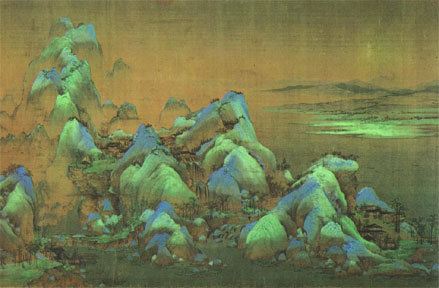
Wang XiMeng (1196-1120), A Thousand Li of Rivers and Mountains,
Song Dynasty
| For the Chinese, God is most evident in the world of nature. Paintings
of mountains, forests, fields, and gardens have the ability to transport
one away from the vexations of the material world into a peaceful, carefree
realm. Because of this, landscape paintings have always been highly regarded
in China. |
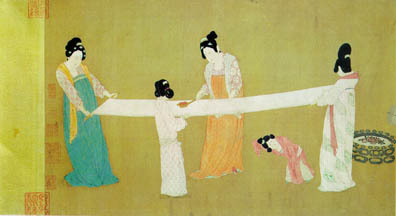
Court Ladies Preparing Silk, Song Dynasty
| Chinese paintings are frequently created with watercolors on fine silk,
in long scrolls. Sometimes a painting is meant to tell a narrative story
and is "read" like a book. A handscroll is one long horizontal
piece of material which is held in the hands and rolled from end to end. |
| Whether Chinese painting is "realistic" is the object of frequent debate.
The kind of "realism" sought after in Chinese painting is not an objective
reflection of the existence of an object as perceived through the sense
of sight, but rather is an expression of a subjective kind of recognition
or insight. No effort is made to represent the shadows cast by a particular
type of lighting, and for this reason the painting does not have a clear
three-dimensional effect. Instead, the artist strives for an understanding
of the graceful lines within nature, and prefers to set the imagery against
a plain background. |
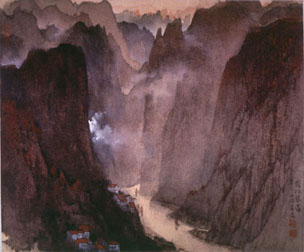
Song Wenzhi |
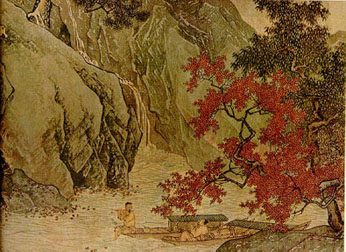
Tang Yin, Mountain Landscape |
| When humans are present within landscape painting, the artist frequently
minimizes their importance within the vastness of nature. |
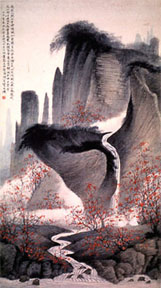
He Tianjian, Autumn Scene |
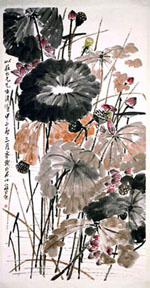
Qi Bashi, Pond Plants |
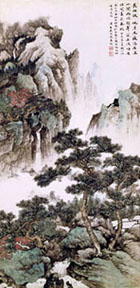
Wu Hufan, Scholars |
| After the painter sets the lines down on the paper, he uses watercolor
wash techniques to achieve a chiaroscuro effect of light and dark,
representing the forces of "yin" and "yang", to express his grasp of the
eternal quintessential nature of his subject. There is a very strong relationship
between poetry, calligraphy, and painting in China. After the Song Dynasty,
it is rare to find a Chinese painting that does not include calligraphic
inscriptions of poetry prominently displayed within the work. |
| One artist well known for paintings inpired by poetry is that of Ren
Xong. Above are two out of a suite of 120 leaves of an album the artist
created while staying with a poet-friend, Yao Xie. The paintings are reportedly
inspired by his friend's poetry and all were created over a two month
period in the winter of 1850 and 1851. The artist takes great liberties
with nature in these paintings, achieving instead a world of rich fantasy. |
See Chinese Painting After Socialist Republic
Japan: Masters of Woodblock
Printing
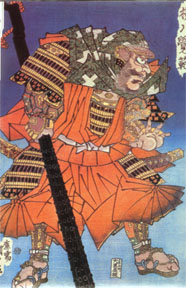
Kunisada, Warrior-Monk 1830 |
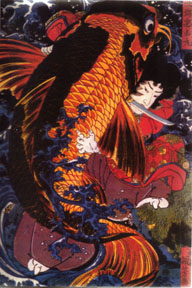
Kuniyoshi, Oniwaka Fighting Giant Carp 1830 |
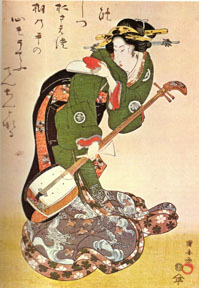
Kuniyasu, Girl with Samisen, c. 1830 |
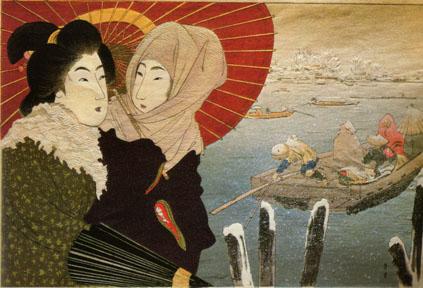
Shoun, Winter scene from The Four Seasons, c. 1900 |
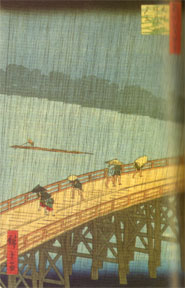
Hiroshige, Rain Shower |
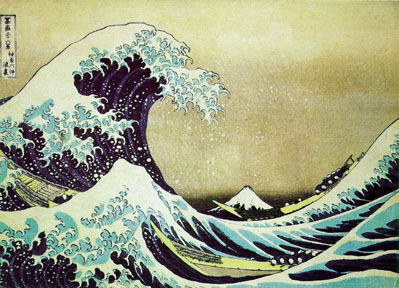
Hokusai, The Great Wave, 1823 |
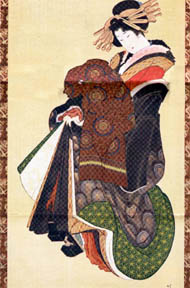
Hokusai, Courtesan 1812
|
Hokusai (1760-1849), Japan's best known artist, lived during
the Shogun period - at which time Japan had sealed itself off from the
rest of the world. Contact with Western culture was forbidden. Nevertheless,
Hokusai discovered and studied the European copper-plate engravings that
were being smuggled into the country. Here he learned about scientific
perspective, shading, coloring, realism, and landscape perspective. He
introduced all of these elements into woodblock and ukiyo-e art and thus
revolutionized and invigorated Japanese art. Although Chinese and Japanese
paintings had been using long distance landscape views for 1,500 years,
this style had never entered the woodblock print. Ukiyo-e woodblocks were
produced for bourgeoisie city gentry who wanted images of street life,
sumo wrestlers, and geishas. The countryside was ignored; it was for peasants.
Instead of shoguns, samurai, and their famous geishas, Hokusai placed
the common man into his woodblocks, moving the emphasis away from the
aristocrats and down to the rest of humanity. In The Great Wave, tiny
humans are tossed around under giant waves, while enormous Mt. Fuji is
a hill in the distance.
|
Next: Mesoamerican Art
|